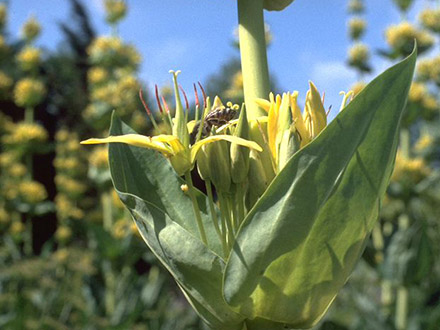Botanical name
Yellow Gentian - Gentiana lutea L.
Family
Gentian Family (Gentianaceae)
Common name
Great yellow gentian, Yellow gentian, Bitter root, Bitterwort, Felwort, Pale gentian, Gall weed
Information about the plant
Yellow gentian is a Central and Southern European mountain plant and grows in the Alpine foothills, the Alps, the Jura, the Massif Central, the Pyrenees, the Black Forest and the Vosges. It grows on pastures, unfertilized hay meadows, cirque meadows, thickets, scree slopes and on cliffs. The genus name Gentiana comes from King Gentius, the last king of the Illyrian Labeats in Shkodra (now Albania), who is said to have recognized the effectiveness of the yellow gentian root. The epithet lutea (Latin "luteus" = yellow) refers to the yellow color of the blossom. The German name Enzian is derived from the scientific genus name with the loss of the "G", Old High German 'genciane'.
Yellow gentian grows up to 45 to 140cm high, its main roots can reach a length of up to one meter. The stem is hollow and as thick as a finger, at the bottom it has large elliptical, arched leaves. The yellow flowers have long stalks and bear 3 to 10 flowering cymes in the axils of cup-shaped bracts. The fruit is a pointed cone-shaped capsule, up to 6cm long with numerous seeds. The flowering time is from June to August.
Gentian brandy (“Enzler") comes from the fresh root of the plant. The roots are left to ferment, then dried, chopped, washed with water, and fermented again. The fresh roots can also be left ferment directly or by mashing the fruit. When distilling the brandy, the bitter substances of the yellow gentian are not transferred to the distillate, however the gentian roots give the distillate a very distinctive flavour. Hydroalcoholic extracts of the root contain bitter substances and are used to make aperitif drinks (Alpenbitter, Enzianbitter), usually mixed with other plants containing bitter substances. Due to overharvesting to produce alcoholic beverages, the population of yellow gentian was severely endangered. This led to great efforts to cultivate the plant in Bavaria, which eventually succeeded.
Medicinally used parts of plants (herbal drug)
The underground parts are used, consisting of rhizome (rootstock) and roots (Gentianae radix). The drug comes from wild collections in France, Spain and the Balkan countries, and farms in France and Germany.
Constituents of the herbal drug
Gentian root contains bitter substances from secoiridoid, gentisin (yellow pigment) and carbohydrates (including trisaccharide gentianose).
Quality of the drug
The quality of gentian root (Gentiana radix) is specified in the European Pharmacopoeia (Ph. Eur.).
Medical applications
Recognised medical use
The HMPC has classified gentian root as a traditional herbal medicinal product (see "Traditional use").
ESCOP: as a bitter remedy for loss of appetite, e.g. after illness, and for digestive complaints (dyspeptic complaints).
Traditional use
Gentian root has been classified by the HMPC as a traditional herbal medicinal product (§ 39a AMG). Based on many years of experience, gentian root can be used for temporary loss of appetite and for mild dyspeptic and gastrointestinal complaints.
Herbal drug preparations in finished dosage forms
- Cut drug for tea preparation
- Powdered drug in tablets
- Fluid extract in liquids
- Tincture in drops
- Alcoholic extracts in liquids
- Aqueous extract in liquids
- Gentiana lutea homeopathic mother tincture in drops
Dosage
Finished medicinal products: see patient information leaflet.
Tea infusion: drink a cup of warm Gentian tea 3 to 4 times a day, combined with other drugs such as wormwood, yarrow or centaury (stomach teas). To stimulate the appetite, drink the tea half an hour before meals, with indigestion, drink after meals. Daily dose: 2 to 4g of the drug.
Preparation of a tea
Pour boiling water over 1 to 2g of finely chopped or coarsely powdered gentian root and strain after 5 minutes.
Notes
Gentian root should not be taken in case of existing gastric and duodenal ulcers as well as for stomach hyperacidity.
No studies have yet been carried out on the harmlessness of Gentian root during pregnancy and breast-feeding. The use in children and adolescents under the age of 18 is not recommended due to a lack of evidence.
Side effects
Headaches can sometimes occur.
Interactions
None known
References
Herbal drug monographs
HMPC (2019), ESCOP (2014), WHO Vol. 3
Further literature
Commentary on the European Pharmacopoeia (Gentian root, Nr. 0392)


